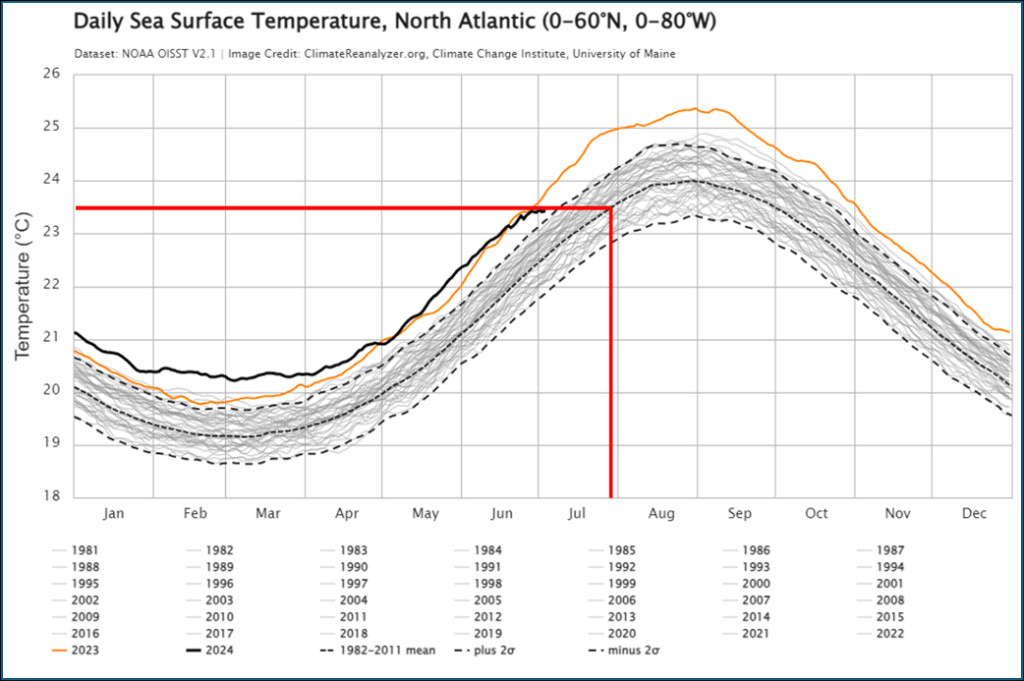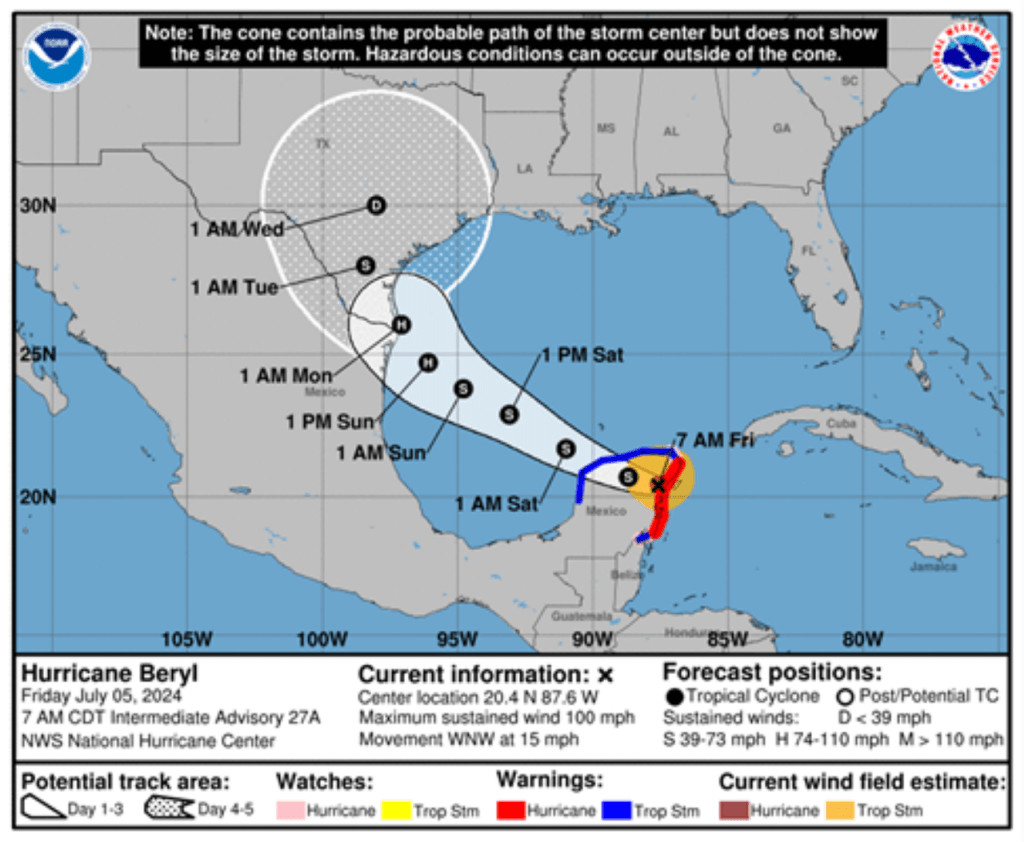Hurricane Beryl, a storm of unprecedented early-season intensity, made its second landfall in Mexico’s Yucatan Peninsula, marking a significant event in the 2024 Atlantic hurricane season. This article delves into the trajectory, impact, and historical context of Hurricane Beryl, drawing insights from expert analysis and official reports to provide a comprehensive understanding of this remarkable weather phenomenon.
Beryl’s Journey: From Record-Breaking Atlantic Storm to Yucatan Landfall
Hurricane Beryl’s journey has been nothing short of extraordinary. Originating in the Main Development Region (MDR) of the Atlantic, a zone notorious for birthing powerful hurricanes later in the season, Beryl defied climatological norms from its inception. Its rapid intensification into a Category 5 hurricane in early July shattered previous records, establishing Beryl as the earliest Category 5 storm ever observed in the Atlantic basin. This unprecedented strengthening was fueled by unusually warm sea surface temperatures and favorable atmospheric conditions, raising concerns about the increasing intensity of early-season hurricanes in a changing climate.
After reaching its peak intensity, Hurricane Beryl made its first landfall as a devastating Category 4 storm over Grenada in the Windward Islands. This initial impact caused significant damage and underscored the destructive potential of such an early major hurricane. Subsequently, Beryl tracked westward towards the Yucatan Peninsula, briefly weakening before regaining strength as it approached the Mexican coast.
On the morning of July 5th, 2024, Hurricane Beryl made its second landfall, this time over the Yucatan Peninsula northeast of Tulum. At landfall, it was classified as a strong Category 2 hurricane, packing maximum sustained winds of 110 mph and a central pressure of 975 millibars. This second landfall brought significant wind and rain impacts to popular tourist destinations along the Riviera Maya, including Cancun, Playa Del Carmen, and Tulum.
Impact on Mexico’s Yucatan Peninsula
The Yucatan Peninsula, renowned for its stunning Caribbean coastline, ancient Mayan ruins, and vibrant tourism industry, braced for impact as Hurricane Beryl approached. While the storm’s center made landfall slightly north of Tulum, the expansive wind field affected a wide swathe of the peninsula.
Initial reports indicated that areas around Cancun and Playa Del Carmen experienced hurricane-force wind gusts. Weather stations recorded gusts reaching 81 mph in Cancun and sustained winds of 59 mph. The impact was felt across the tourism sector, with resorts and businesses taking precautionary measures, and tourists advised to stay indoors.
While the immediate aftermath assessments were underway, the primary concerns included wind damage to infrastructure, particularly older or less robust structures, and the potential for flooding due to heavy rainfall and storm surge. The region’s infrastructure, while generally well-prepared for hurricanes, still faces vulnerabilities, especially in less developed or rapidly growing areas.
 Hurricane Beryl wind history Source: National Hurricane Center, 2024
Hurricane Beryl wind history Source: National Hurricane Center, 2024
The economic impact on the Yucatan Peninsula is anticipated to be substantial, particularly for the tourism industry, which is a cornerstone of the regional economy. Disruptions to travel, temporary closures of resorts and attractions, and potential damage to tourism-related infrastructure could lead to significant financial losses.
Insured Losses and Economic Considerations in Mexico
While the full extent of the damage and economic losses is still being evaluated, initial estimates from CoreLogic Hazard HQ Command Central™ suggested that insured losses in Mexico’s Yucatan Peninsula would be less than $1 billion. This estimate primarily accounts for wind damage to residential, commercial, industrial, and agricultural properties, including contents and business interruption.
It’s important to note that these are preliminary estimates and can be subject to change as more data becomes available and damage assessments are completed. Factors influencing the final insured loss figures include the precise path of the storm, the extent of damage in densely populated versus sparsely populated areas, and the level of insurance coverage in the affected regions.
Compared to other landfalls of Hurricane Beryl, such as in Texas, the estimated insured losses in Mexico are lower. This can be attributed to several factors, including the landfall location over a less densely populated part of the Yucatan Peninsula compared to major Texan cities, and potentially different levels of insurance penetration and policy deductibles.
Hurricane Beryl’s Uniqueness and Historical Context
Hurricane Beryl stands out not only for its early-season Category 5 intensity but also for its overall trajectory and behavior. The storm defied typical patterns for hurricanes in the Atlantic, particularly with its strength so early in the hurricane season.
Dr. Howard Botts, Chief Scientist at CoreLogic, highlighted the unusual nature of Beryl, stating, “To see a major tropical cyclone east of the Caribbean in late June is almost unheard of. A Category 5 hurricane in early July has never been recorded.” This underscores the exceptionality of Hurricane Beryl and raises questions about potential shifts in hurricane climatology.
The historical context further emphasizes Beryl’s uniqueness. Prior to Beryl, the earliest Category 5 hurricane in the Atlantic was Hurricane Emily in July 2005. Beryl surpassed this record by a significant margin, forming and reaching Category 5 strength much earlier in the season. Furthermore, Beryl became the strongest hurricane ever observed in July, again surpassing Hurricane Emily’s previous record.
 North Atlantic sea surface temperatures
North Atlantic sea surface temperatures
These meteorological records set by Hurricane Beryl are linked to environmental factors, particularly the exceptionally warm sea surface temperatures in the Atlantic Ocean and Caribbean Sea. These elevated temperatures provide more energy for hurricanes to intensify, potentially leading to stronger and more frequent early-season storms.
Implications for Future Hurricane Seasons
Hurricane Beryl serves as a stark reminder of the increasing risks associated with hurricanes, particularly in the context of climate change and rising ocean temperatures. The storm’s unprecedented early-season intensity and record-breaking strength underscore the need for enhanced preparedness, robust building codes, and a greater understanding of evolving hurricane patterns.
For regions like Mexico’s Yucatan Peninsula, which are highly exposed to hurricane risks, the experience with Hurricane Beryl highlights the importance of resilient infrastructure, effective early warning systems, and comprehensive disaster management plans. The tourism sector, a vital economic engine for the region, must also adapt to the increasing hurricane threat, implementing measures to protect tourists and minimize disruptions.
 Hurricane Beryl five-day forecast. Source: NHC, 2024
Hurricane Beryl five-day forecast. Source: NHC, 2024
Looking ahead, continued monitoring of Atlantic hurricane activity and ongoing research into the impacts of climate change on hurricane intensity and frequency are crucial. Hurricane Beryl may be an outlier, but it could also be a harbinger of a new era of more intense and unpredictable early-season hurricanes. Understanding these trends is essential for mitigating risks and ensuring the safety and resilience of vulnerable coastal communities in Mexico and across the Atlantic basin.
Disclaimer: This article is based on information available as of the latest updates from CoreLogic Hazard HQ Command Central™ and the National Hurricane Center (NHC). Insured loss estimates are preliminary and subject to change. For the most up-to-date information and official warnings, please refer to the NHC and local authorities.